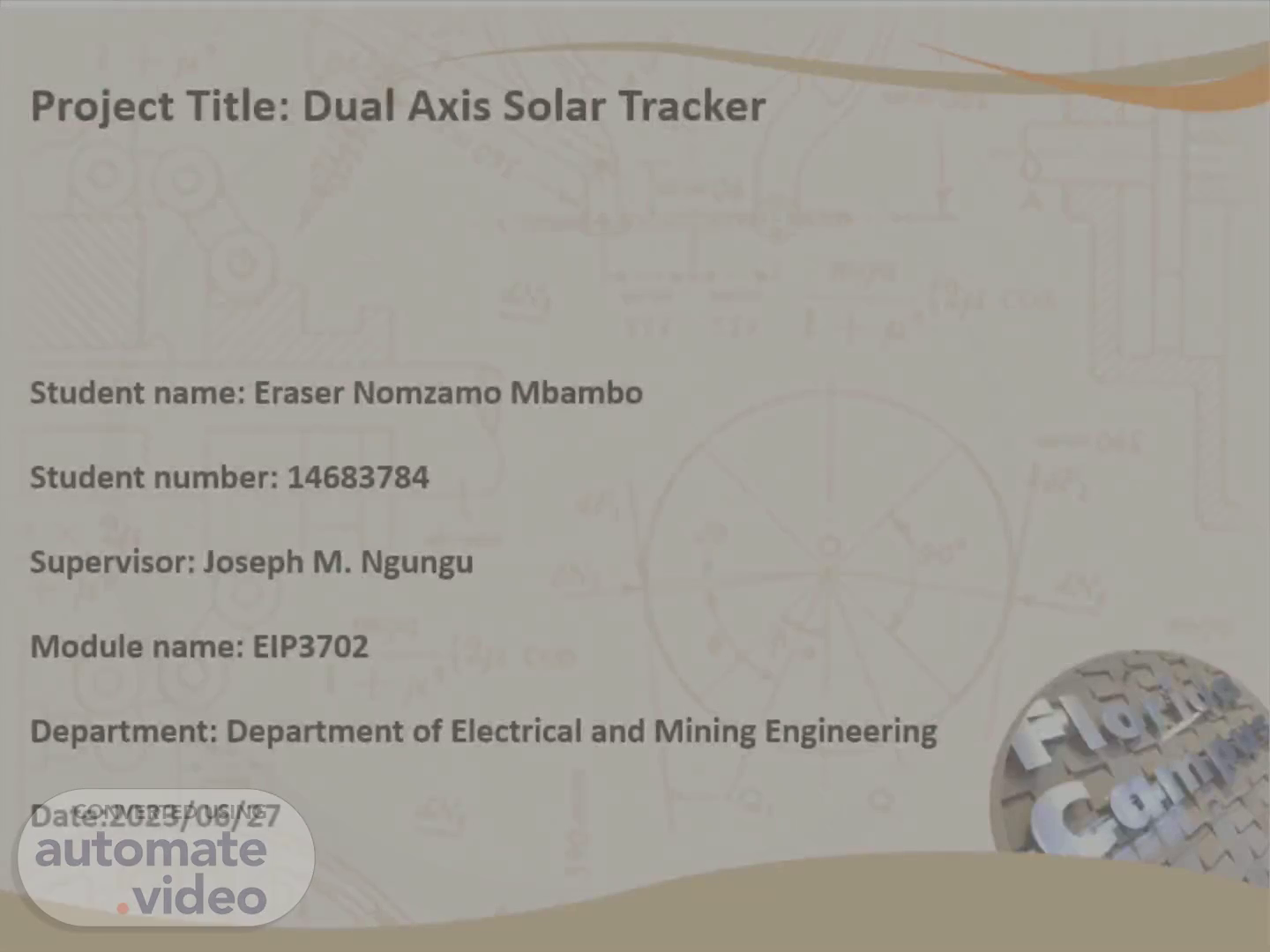
Presentation title goes here (DelargoDT Semi Bold 38pt)
Scene 1 (0s)
[Virtual Presenter] Hi. Welcome to simulation presentation of dual axis solar tracker prototype..
Scene 2 (27s)
[Audio] Increase in the world energy demand has made renewable energy sources one of the best options. It is finding wide utility in comparison with the other sources of energy. Solar energy is one of the major sources of renewable energy. The abundance of solar energy in South Africa makes it highly desirable to exploit but due to the limitations of technology, only a fraction of the energy can be extracted and used. This is simulation and prototype development of dual axis solar tracking system. The system uses only four units of identical light-detecting- resistors (LDR) arranged on the four sides of solar Pv and can track the light source position at the strongest intensity of visible light. Based on comparative study of outputs of all the four LDRs, the panel will tilt to get maximum output from the system..
Scene 3 (1m 26s)
[Audio] Prototype simulation. The following videos present electrical and mechanical simulation of the prototype..
Scene 4 (1m 37s)
[Audio] Electrical circuit simulation. Servo-motors are electromechanical devices that can rotate to specific angles based on input signals. Input signal is calculated using the average light received by LDR sensors. Average of Left+Right LDRs Versus Top + Bottom LDRs average determines rotation angle of both servo motors. This video present the horizontal and vertical axis rotation of solar tracker.In this simulation, The microcontroller controls the servo motors by setting pins on the output ports that are connected to the motor input. These pins represent the Pulse Width Modulation (PWM) for the servo motors input to control the angle of their rotation. The value of PWM that is fed into the servo motors is dependent on the input from the light sensor to control the angle of elevation and altitude of the sun or the light source. Example, . For azimuth tracking, the average values from two right LDRs and two left LDRs are compared and if the left set of LDRs receive more light, the horizontal servo motor will move in that direction (Rotates Clockwise (CW)). The servo motor will continue to rotate until the difference result is between a positive threshold value (10) and a negative threshold value (-10), which means that the solar tracker is approximately perpendicular to the light source. If the right set of LDRs receive more light, the horizontal servo motor moves in that direction (Rotates Counterclockwise (CCW)) and will continue to rotate until the difference result is between 10 and -10. The same way is used for elevation tracking. We also determined the average radiation between the four LDRs, the idea being that at the end of the day, when the solar projection is null, the solar tracker returns to its initial position, waiting for a new day. At noon, when the sunlight is at maximum, the servo motors must be stopped. All this is presented on this video..
Scene 5 (5m 0s)
[Audio] The following slide presents the Mechanical structure of the prototype. In the figure attached, is the Physical structure constructed from the simulation. The structure is constructed with mounting bracket shaft, two servo-motors, horizontal and vertical axis. The Arduino microprocessor controls the system using 4 LDR sensors as input signal to trigger rotation of servos..
Scene 6 (5m 29s)
[Audio] Vertical axis solar tracking system. The Mounting bracket connected vertically to bottom(horizontal)servo-motor allows for vertical rotation on PV..
Scene 7 (5m 45s)
[Audio] Horizontal Axis Rotation. The horizontal servo(servo-2 ) has mounting bracket vertically mounted to it. This servo-motor is for horizontal rotation of the system.
Scene 8 (6m 16s)
[Audio] This project focuses on developing a functional prototype on a small scale. The physical size and capacity of the solar panels and servo motors are limited to a specific range suitable for demonstration purposes. Scaling up the prototype for larger solar panel arrays may require further considerations and modifications. In conclusion, the development of a dual-axis solar tracker prototype presents a promising solution for maximizing solar energy utilization and mitigating the effects of load shedding. Throughout the course of this project, significant progress has been made in addressing the challenges associated with solar tracking technology. The prototype successfully demonstrated the feasibility and potential benefits of implementing a dual-axis solar tracking system..